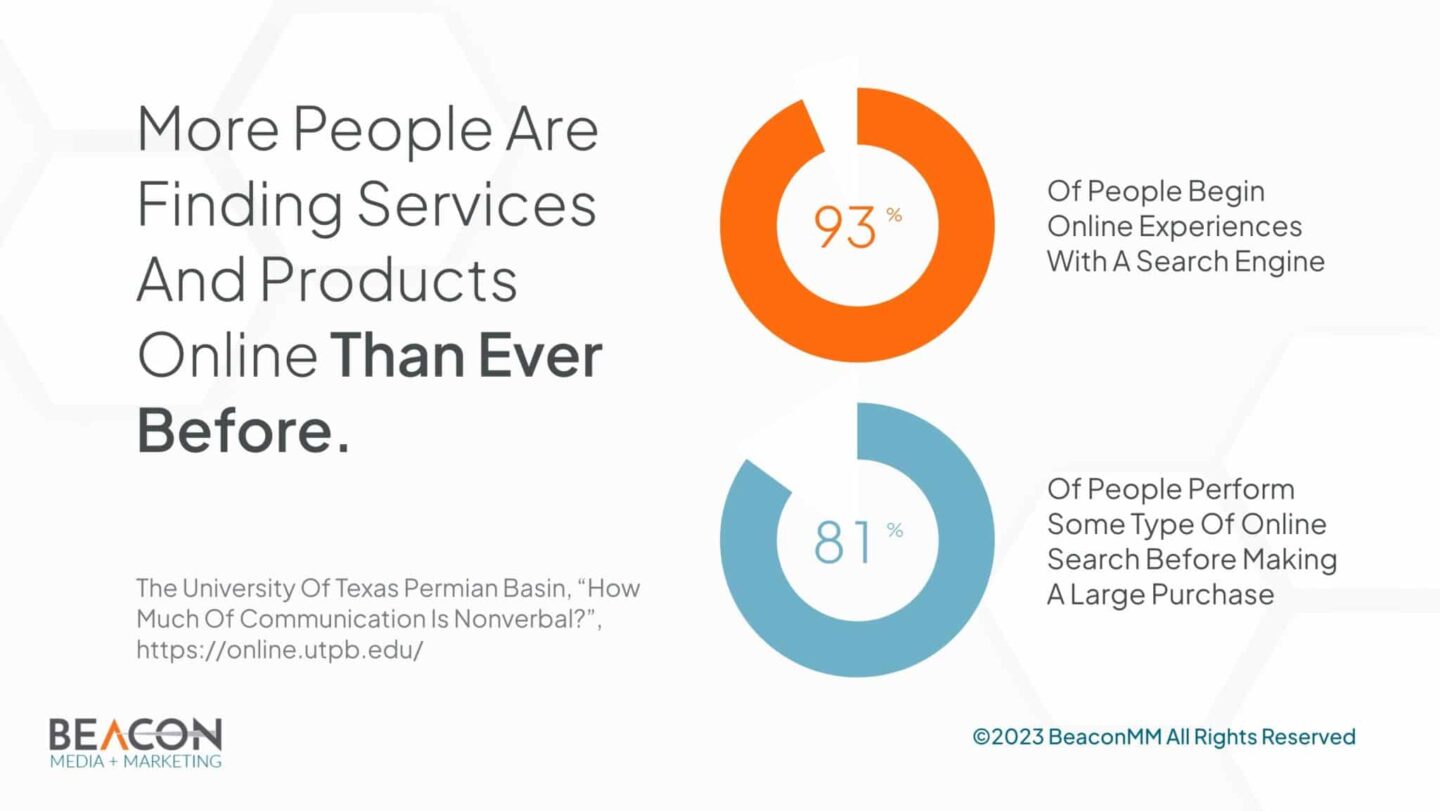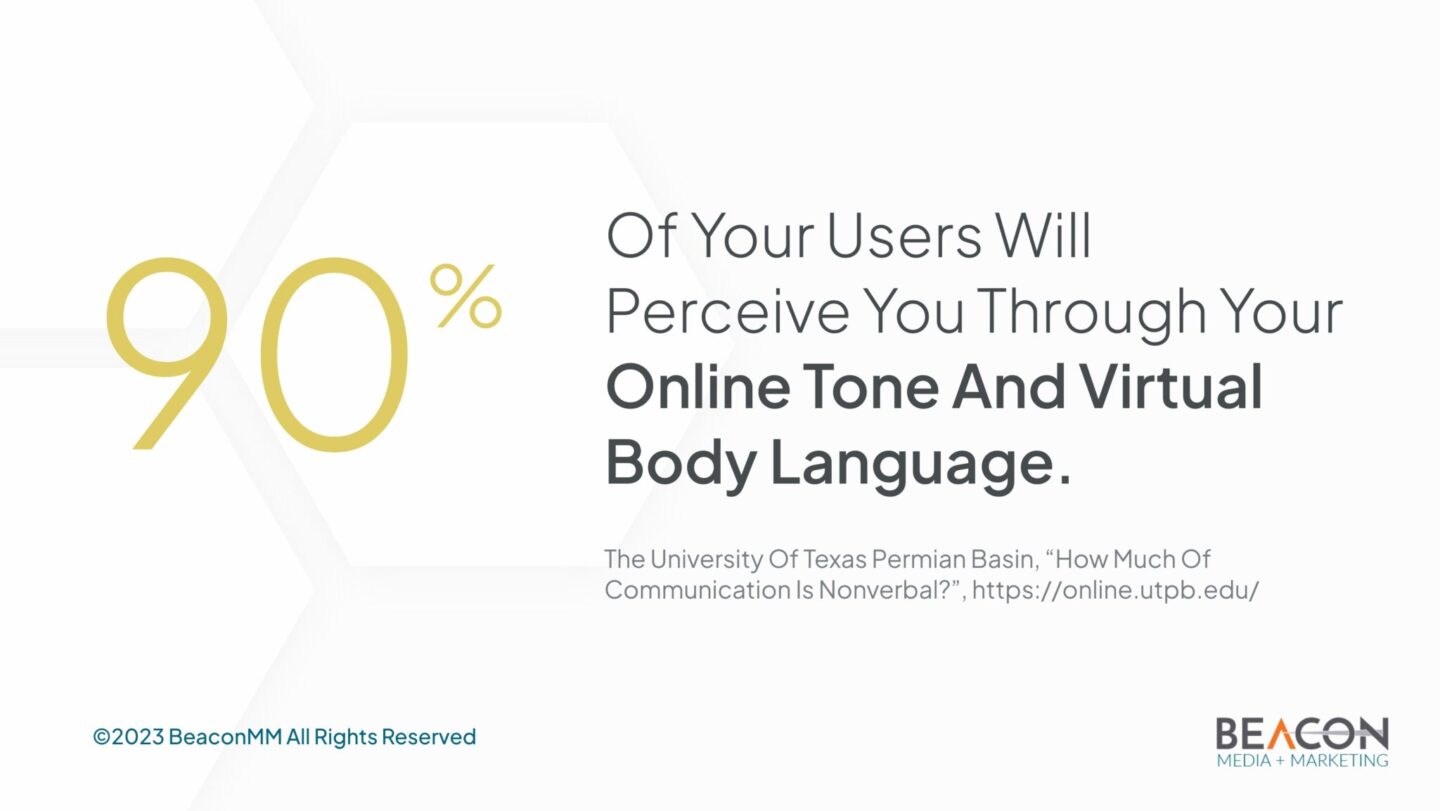What is the Beacon Way and why is it impacting the digital marketing industry?

The Beacon Way is something that we have been formulating, testing, and using for our clients over the past several years. We’ve been able to put together a methodology around the most successful pieces that any business needs to have as part of its marketing plan.
The Beacon Way focuses on your digital footprint and its human connection in a digital world of disconnection.
Can you explain why human connection is important in a digital format?

93% of people begin online experiences with a search engine and 81% of people perform some type of online search before making a large purchase. Even though they start online and are getting the information they’re looking for from a digital platform, they don’t want to be sold and they don’t want to be just a number, they want to be a customer, a fan of your company, and possibly an unpaid brand ambassador for your services based on the experience they have once they decide to make that initial contact.
Bringing humanity back into the digital equation humanizes what has become largely dehumanized. We have found that the more we bring that human-to-human connection back into digital marketing, it transforms the whole buying process.
To put it simply, The Beacon Way cultivates conversations and connections with your ideal clients. It brings digital marketing back to the human level, which directly affects your bottom line, your brand, and your ability to recruit people to work for you.
How do you formulate a marketing plan based on The Beacon Way?
A good in-person networker knows that to connect on a human level, you have to watch how you use speech and body language to invite conversation. Closed body language, like directly facing one person instead of a more open stance, does not invite others into your sphere for connection and conversation. A simple side step to open your shoulders to the room shows people that you are open to them coming toward you, inviting them into the conversation. This applies to your digital presence as well, a website that is not easily navigated and appears cold, does not as easily invite the potential client to continue to explore the conversation.
Taking a step back with fresh eyes to analyze your online presence is the first step to solid plan formulation. 90% of how potential clients will perceive you is in the “tone and body language” of your online presence, how is your conversation and your communication? Do the words you use make them feel comfortable? Is your color scheme welcoming? Is the general theme of the website welcoming or is it cold and off-putting? Are you communicating clearly with your potential clients that they have found whom they are looking for or are they having to hunt and struggle to discover that you are the solution they are looking for?
For example, when a potential client is looking for your contact information, is it easily accessible on your website or is it hidden? If information is not easily accessible, it will cost you in your conversions. 93% of potential clients are going to check out your online profile first. If your online profile does not reflect the correct tone, the correct body language, and use the words that you would express in person, that can cause you to miss out on a huge percentage of potential new clients. You risk turning this first impression from a welcoming invitation to explore more of who you are into a transactional experience, people don’t want to be sold, they want to connect.
The core of The Beacon Way is being open and attentive to the tone and body language of your digital presence and translating human-to-human interaction skills into that digital presence to engage and convert potential clients into customers and fans.
How can The Beacon Way enhance the UX experience?

The UX experience, or user experience, is what the potential client will encounter when they click on your website. This is why exploring tone, body language, and words is so very important. That first impression needs to remove as many barriers as possible to ensure that they stay on your site and browse for more information.
When a potential client lands on your home page or your services page from a Google post, what do you optimally want them to experience? Statistics show that if a website doesn’t load within 1-2 seconds, the user will click off of it, with the majority of people not staying past 3 seconds. Focusing on the back-end technical foundation of your website is a critical step to ensuring a solid UX experience. Many tools are available, either through paid or free subscriptions, to analyze this functionality.
Having a website that does not load quickly is a frustrating experience, it communicates to the potential client that their time is not valuable to you and that you don’t want to talk to them. It may seem extreme, but not when you consider the subconscious message the user receives that creates the click-off after a max of 3 seconds.
The second most important thing to consider is the content on that page of your website, does it communicate clearly the relevant information that your potential client is looking to learn? We know that intrinsically, in networking or in building a relationship with someone, we have to cultivate a curiosity from them so that they want to learn more but also, it’s being curious about them and learning about them first. We have to give them information relevant to what they are searching for, establish ourselves as the expert without being salesy, and create a lasting positive first impression.
All of these items do take time to review and make right, but once you have them right and understand the process of what your potential clients are looking for, you can start seeing great increases and better conversions.
How can I look at my website through The Beacon Way?
Again, start by taking a look at the foundational technical items on the back end of your website. Does it load fast enough, is it accessible quickly? Are you prepared for the moment that you initially meet your potential client and are you putting a positive first impression forward to them each and every time?
Next, look to see if you are ranking well. Your presence will be solid if your website loads quickly, you don’t have off-putting spam on your website, and your domain is updated. Clearly stating what you do, thinking clear over creative, and not getting distracted by adding all the bells and whistles to your page, will help you stand out from your competitors. Ultimately, the goal should be, “This is who I am and why I’m different from my competitors. I do what I do really well and I can actually help you.”
Communication of whom you actually help is a very important part of your digital presence. If a potential client comes to your site, they need to clearly understand that you can provide a solution to what they are searching for. Potential Clients don’t want to read between the lines and wonder if your service is the right one for them, they want to know they’ve chosen well and feel comfortable when choosing you.
What about design? Doesn’t that matter?
Absolutely, however, it doesn’t matter over content and UX. You can have an outrageously designed site, but the client has no idea who you are, what you do, or how to get in contact with you. It is not about how flashy your website or online presence is, you have to cultivate connections with your ideal clients and be super obvious about whom you help and how they can contact you because those are two very large barriers to client conversions.
The Beacon Way of marketing is cultivating connection that leads the potential client from the initial connection to an actual converting client by having a good UX experience that ties back to the human connection in digital marketing.
If you were to prioritize changes using The Beacon Way, what would they be?
Start thinking about your website objectively, are you making that human-to-human connection with your digital marketing? What about your tone and how fast does your website load? Are you taking the time to make sure your website body language is working? How easy is it to find the information you want to provide for your UX? Are you communicating that you want potential clients on your website to explore and receive information or are you trying to instantly funnel them into a sales situation?
Make sure the words you are using are welcoming and communicating clearly while using a good tone. Words matter less if you have already lost your viewer in the first few categories.
How can we get more in-depth information on removing barriers from potential clients?
Check out episode 5 of The Beacon Way podcast or our blog, Removing Barriers in Marketing!






